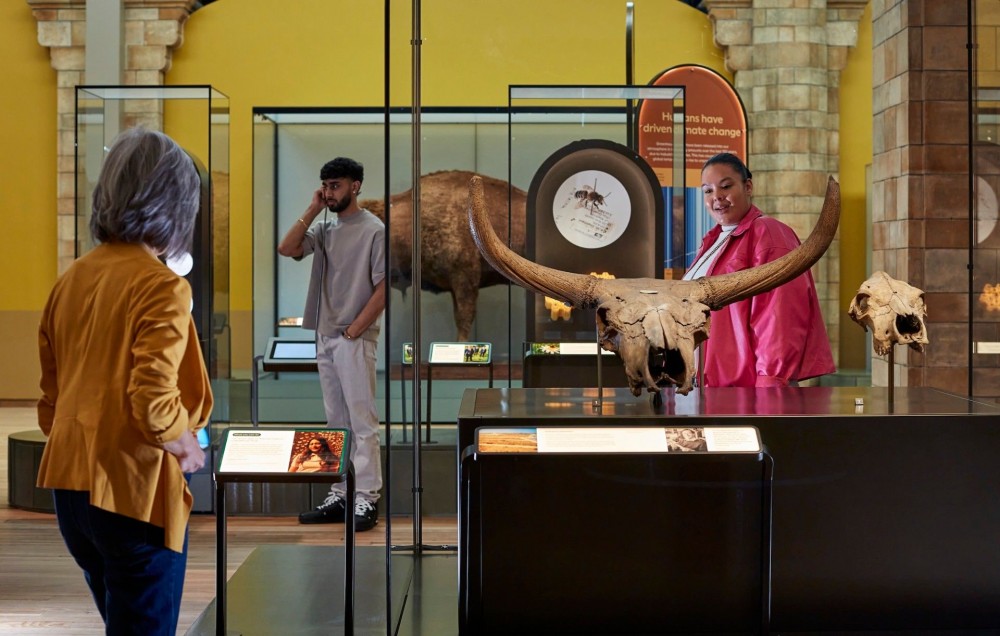
One million people have visited Fixing Our Broken Planet, the Museum's new gallery © The Trustees of the Natural History Museum, London
The Natural History Museum’s permanent free-to-visit gallery, Fixing Our Broken Planet, has welcomed its one millionth visitor just four months after opening its doors. Its popularity cements the gallery as a hub for the public to learn and have conversations about the science-backed, hopeful solutions to slowing climate change and restoring biodiversity.
Since April, 43% of visitors to the Museum headed to the new gallery to see how Museum scientists and specimens from the natural world are unlocking solutions to the planetary emergency.
The 200-plus specimens on display, including new species from the deep sea, and the associated science told by some of the Museum’s 400 scientists were chosen to empower the public to become advocates for the planet. To date, 82% of visitors said that they were more likely to take action to protect the natural world following their visit to the gallery.
Dr Doug Gurr, Museum Director, said: “This incredible milestone is a clear sign that there is a real public appetite to engage with addressing the planetary emergency and that cultural institutions have a vital role to play in driving that conversation forward.
“In a world where climate anxiety, apathy and misinformation can feel overwhelming, Fixing Our Broken Planet shows that people have cause to feel hopeful and to feel part of a larger community taking action for the planet.”
Hitting this milestone means one million people took time to learn about the current research underway behind the scenes at the Museum, such as discovering how to breed climate-resistant wheat and the innovative work breaking the cycle of parasitic worm infections in Benin, India and Malawi.
A free online tool, Find Your Climate Action, launched in tandem with the gallery to provide the public with practical steps they could take to benefit themselves and the planet. Of the actions listed on the tool, the most popular (in terms of users pledging to make the change) was making the switch to a greener bank.
The scientific research continues behind the scenes and, since April, researchers at the Museum have published 165 papers on topics ranging from food security, protecting global seaweed populations, and resourcing the green economy.
In unison with the ongoing science unlocking the potential of natural history, the gallery is a central part of the Museum’s mission to inspire over 100 million advocates for the planet. This ambition is being realised through a transformation of its South Kensington building and a series of far-reaching advocacy programmes - including Fixing Our Broken Planet, the Urban Nature Movement and Wildlife Photographer of the Year.
To support this bold vision ahead of its 150th anniversary in 2031, the Museum has launched NHM150, a campaign to raise an additional £150 million from philanthropists and corporate partners.
NHM150 is already delivering significant results - enriching the Museum’s public offering and drawing record numbers of visitors to South Kensington, which welcomed over 6.3 million people last year. Alongside the remarkable success of Fixing Our Broken Planet, the reimagined gardens, which opened just over a year ago, have already attracted more than 5 million visitors.
By 2031, the Museum will have unveiled two stunning new galleries and transformed four existing ones – creating beautiful new spaces to share its treasures from the natural world with over a million more visitors every year and placing its world-leading scientific expertise at the heart of the visitor experience.
The Department for Culture, Media and Sport's Public Bodies Infrastructure Fund (PBIF) awarded the Museum with significant funding to rebuild the gallery whilst retaining its heritage and charm.
A wide variety of trusts, foundations, organisations, companies and individuals are supporting the Fixing Our Broken Planet gallery and programme including Natural Environment Research Council (NERC), part of UK Research and Innovation, Wellcome, The Claude and Sofia Marion Foundation, GSK and Ørsted.
* * *
The Natural History Museum is a world-leading scientific research centre and one of the world’s most visited museums. Our mission is to create advocates for the planet – people who act for nature.
Our 400 scientists are finding solutions to the planetary emergency - from reversing biodiversity loss to resourcing the green economy.
We are seeking an additional £150 million to transform our South Kensington building: placing our groundbreaking research at its heart, revitalising four existing galleries, opening two new magnificent galleries and delighting 1 million more visitors a year with the wonders of the natural world.
The Department for Culture, Media and Sport's Public Bodies Infrastructure Fund
DCMS's Public Bodies Infrastructure Fund supports the Department's arts and cultural public bodies in addressing urgent and critical estates maintenance challenges.
Natural Environment Research Council
NERC is the custodian of the UK’s environmental science. It ensures the UK has the diverse talent and skills, the facilities, and the infrastructure needed for world-leading research. NERC researchers diagnose environmental issues, mitigate risk, and support solutions to major challenges such as air quality and climate change for the UK and beyond.
Wellcome
Wellcome supports science to solve the urgent health challenges facing everyone. We support discovery research into life, health and wellbeing, and we're taking on three worldwide health challenges: mental health, infectious disease and climate and health.
The Claude and Sofia Marion Foundation
The Claude and Sofia Marion Foundation is dedicated to advancing and promoting charitable endeavours on a global scale. With a special emphasis on education for at-risk youth, the Foundation also supports initiatives in healthcare, environment, sustainability, culture, and social programs aimed at alleviating poverty. Through these efforts, the Foundation seeks to foster meaningful and lasting improvements worldwide.
GSK
GSK is a global biopharma company with a purpose to unite science, technology, and talent to get ahead of disease together. Find out more at gsk.com/company.
Ørsted
Ørsted are one of the world’s leading renewable energy companies that takes tangible action to create a world that runs entirely on green energy.

